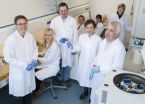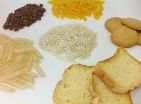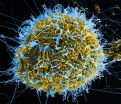Informative visit to the toilet
Study shows lemurs use communal latrines as information exchange centers
2014-10-16
(Press-News.org) Emily loves Justin - Stop global warming - Two more weeks till I graduate!: The exchange of information in public toilets is widespread. It also occurs in the world of white-footed sportive lemurs. Only instead of writing on the walls, they use scent-marks in order to communicate with their own kind. In a study published online in Springer's journal Behavioral Ecology and Sociobiology, Iris Dröscher and Peter Kappeler from the German Primate Center (DPZ) have found that the urine left on latrine trees serves as a method to maintain contact with family members. It also serves as a means to inform an intruder that there is a male that will defend his partner. Latrines thus serve as information exchange centers and promote social bonding in territorial nocturnal animals that do not live in closely-knit groups.
In the animal kingdom, the use of latrines, which serve as specific locations for urination and defecation, is a common occurrence. Because little is known about why primates, in particular, use the same latrines over and over, the researchers set out to investigate this phenomenon among white-footed sportive lemurs (Lepilemur leucopus) in southern Madagascar. Do they hint to others that they want to defend their mate or territory? Or, do they indicate the fertility of the female? Or do they promote exchange of information within a group and support social bonding? To answer these questions, the researchers wanted to establish where such latrines were found, and if they were used differently between seasons and between individuals of different ages and sexes. In the process, Dröscher and Kappeler spent over 1,000 hours watching the toilet habits of 14 radio-collared adult sportive lemurs.
White-footed sportive lemurs are nocturnal tree-dwellers that are found exclusively in southern Madagascar. They live together in families consisting of parents and their offspring. Even though the family members share a common territory, the individuals do not interact much. Neither do pair-partners sleep in the same tree nor do they associate while foraging. But what they have in common are latrines that are located in the core of their territory. All members of the family visit the same latrines for defecation and urination. Dröscher and Kappeler believe the latrines are a way in which to maintain familiarity and social bonding among members of a social unit, who otherwise have very little contact with each other. Such scent signals are picked up from urine that stains the tree trunks rather than feces that accumulate on the ground under the trees.
Males visited the latrines more often during nights when an intruder invaded the territory. In addition, the males placed scent marks from their specialized anogenital glands preferentially in latrines. "This indicates that latrine use in this primate species should also be connected to mate defense," says Iris Dröscher, a PhD student at the German Primate Center.
"Scent marks transmit a variety of information such as sexual and individual identity and may function to signal an individual's presence and identity to others," continues Dröscher. "Latrines therefore serve as information exchange centers of individual-specific information."
"Especially nocturnal species with limited habitat visibility and low inter-individual cohesion profit from predictable areas for information exchange to facilitate communication," says Peter Kappeler, head of the Department for Behavioral Ecology and Sociobiology at the DPZ. "The white-footed sportive lemur has found these information centers by means of latrine use."
INFORMATION:
Reference: Dröscher I, Kappeler PM (2014): Maintenance of familiarity and social bonding via communal latrine use in a solitary primate (Lepilemur leucopus). Behavioral Ecology and Sociobiology, DOI 10.1007/s00265-014-1810-z
The full-text article and photos are available to journalists on request.
[Attachments] See images for this press release:

ELSE PRESS RELEASES FROM THIS DATE:
2014-10-16
The number of overweight persons is greatly increasing worldwide - and as a result is the risk of suffering a heart attack, stroke, diabetes or Alzheimer's disease. For this reason, many people dream of an efficient method for losing weight. An international team of researchers led by Professor Alexander Pfeifer from the University Hospital Bonn, have now come one step closer to this goal. The scientists discovered a new way to stimulate brown fat and thus burn energy from food: The body's own adenosine activates brown fat and "browns" white fat. The results are now being ...
2014-10-16
Rice is one of the few cereal grains consumed by people with celiac disease, as it does not contain gluten. However, it can have high concentrations of a toxic substance – arsenic – as revealed by the analyses of flour, cakes, bread, pasta and other foods made with rice, conducted by researchers from the Miguel Hernández University of Elche, Spain. The European Union is working to establish the maximum quantities of arsenic in these products.
Celiac disease affects almost 1% of the population of the western world, a group which cannot tolerate gluten ...
2014-10-16
Pre-eclampsia, the potentially deadly condition that affects pregnant women, may be caused by problems meeting the oxygen demands of the growing fetus, according to an editorial in the November issue of Anaesthesia, the journal of the Association of Anaesthetists of Great Britain and Ireland (AAGBI).
The finding has promoted the co-author of the editorial, Associate Professor Alicia Dennis, Consultant Anaesthetist & Director of Anaesthesia Research at the Royal Women's Hospital in Melbourne, Australia, to call for the name of the condition to be changed to make women ...
2014-10-16
This news release is available in French. Although progress has been made in recent years, the matter of youth suicide in Quebec still needs to be more effectively addressed. In fact, a new study in the Canadian Journal of Psychiatry shows that more lives could be saved through early detection and increased public awareness and information sharing among professionals.
For this research, a team of scientists from the Douglas Mental Health University Institute and McGill University studied 67 suicide completers ages 25 and under and matched them with 56 living control ...
2014-10-16
A study recently published in the Journal of the American Academy of Dermatology shows that for Ebola, measles, syphilis and many other conditions with skin manifestations the mortality rates are hundreds of times higher in developing countries than they are in developed countries. The case of Ebola, the paper writes, "Highlights the importance of monitoring disease burden in the developing world even when the burden is low."
"Our goal is to provide information about trends and patterns to bring to light what's going on around the world so that funds can be allocated ...
2014-10-16
CHAMPAIGN, Ill. — River beds, where flowing water meets silt, sand and gravel, are critical ecological zones. Yet how water flows in a river with a gravel bed is very different from the traditional model of a sandy river bed, according to a new study that compares their fluid dynamics.
The findings establish new parameters for river modeling that better represent reality, with implications for field researchers and water resource managers.
"The shallow zones where water in rivers interacts with the subsurface are critical environmentally, and how we have modeled ...
2014-10-16
A new study brings good news to all the brothers out there: Having a sibling is just as good for you as it is for your sister.
That's surprising to family scholars because boys typically report that they benefit less than girls from peer relationships.
"In our study, most relationships were not as important for boys as they were for girls," said study co-author Laura Padilla-Walker. "But the sibling relationship was different – they seemed to report relying on sibling affection just as much as girls do. It's an area where parents and therapists could really help ...
2014-10-16
PULLMAN, Wash. – Washington State University researchers have developed a new catalyst that could lead to making biofuels cheaply and more efficiently.
Led by Voiland Distinguished Professor Yong Wang, the researchers mixed inexpensive iron with a tiny amount of rare palladium to make the catalyst. Their work is featured on the cover of the October issue of the journal ACS Catalysis.
Removing oxygen for better fuel
Researchers, government leaders and industry leaders are interested in renewable biofuels as a way to reduce national dependence on fossil fuels and ...
2014-10-16
ANN ARBOR—Adults over 50 who feel comfortable about aging are more proactive in getting preventive health care services, a new University of Michigan study found.
Sometimes, the older population does not visit their doctor because they believe that physical and mental declines typify old age, says Eric Kim, a U-M doctoral student in clinical psychology. They think that lifestyle changes will not make a difference, making them less likely to seek preventive care. This is not true and also not a healthy mindset, he says.
Studies show that older adults can go down ...
2014-10-16
Kyoto, Japan — Researchers in Japan have developed a novel yet simple technique, called "diffusion driven layer-by-layer assembly," to construct graphene into porous three-dimensional (3D) structures for applications in devices such as batteries and supercapacitors. Their study was recently published in the journal Nature Communications.
Graphene is essentially an ultra-thin sheet of carbon and possesses exciting properties such as high mechanical stability and remarkable electrical conductivity. It has been touted as the next generation material that can conceivably ...
LAST 30 PRESS RELEASES:
[Press-News.org] Informative visit to the toilet
Study shows lemurs use communal latrines as information exchange centers







